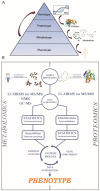Proteomics and Metabolomics for Cystic Fibrosis Research
- PMID: 32751630
- PMCID: PMC7432297
- DOI: 10.3390/ijms21155439
Proteomics and Metabolomics for Cystic Fibrosis Research
Abstract
The aim of this review article is to introduce the reader to the state-of-the-art of the contribution that proteomics and metabolomics sciences are currently providing for cystic fibrosis (CF) research: from the understanding of cystic fibrosis transmembrane conductance regulator (CFTR) biology to biomarker discovery for CF diagnosis. Our work particularly focuses on CFTR post-translational modifications and their role in cellular trafficking as well as on studies that allowed the identification of CFTR molecular interactors. We also show how metabolomics is currently helping biomarker discovery in CF. The most recent advances in these fields are covered by this review, as well as some considerations on possible future scenarios for new applications.
Keywords: biomarker discovery; cystic fibrosis; interactomics; metabolomics; post-translational modifications; proteomics.
Conflict of interest statement
The authors declare no conflict of interest.
Figures



References
Publication types
MeSH terms
Substances
Grants and funding
LinkOut - more resources
Full Text Sources
Medical

